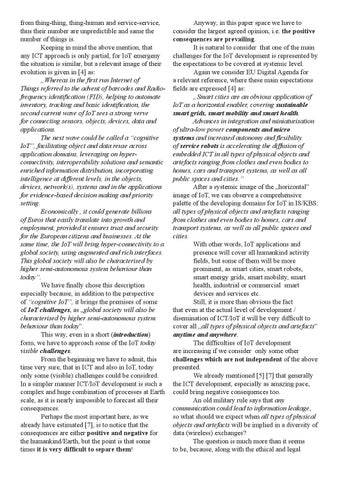from thing-thing, thing-human and service-service, thus their number are unpredictible and same the number of things is. Keeping in mind the above mention, that any ICT approach is only partial, for IoT emergeny the situation is similar, but a relevant image of their evolution is given in [4] as: „Whereas in the first run Internet of Things referred to the advent of barcodes and Radiofrequency identification (FID), helping to automate inventory, tracking and basic identification, the second current wave of IoT sees a strong verve for connecting sensors, objects, devices, data and applications. The next wave could be called a “cognitive IoT”, facilitating object and data reuse across application domains, leveraging on hyperconnectivity, interoperability solutions and semantic enriched information distribution, incorporating intelligence at different levels, in the objects, devices, network(s), systems and in the applications for evidence-based decision making and priority setting. Economically , it could generate billions of Euros that easily translate into growth and employment, provided it ensures trust and security for the European citizens and businesses. At the same time, the IoT will bring hyper-connectivity to a global society, using augmented and rich interfaces. This global society will also be characterised by higher semi-autonomous system behaviour than today”. We have finally chose this description especially because, in addition to the perspective of “cognitive IoT”, it brings the premises of some of IoT challenges, as „global society will also be characterised by higher semi-autonomous system behaviour than today”. This way, even in a short (introduction) form, we have to approach some of the IoT today visible challenges. From the beginning we have to admit, this time very sure, that in ICT and also in IoT, today only some (visible) challenges could be considred. In a simpler manner ICT/IoT development is such a complex and huge combination of processes at Earth scale, as it is nearly impossible to forecast all their consequences. Perhaps the most important here, as we already have estimated [7], is to notice that the consequences are either positive and negative for the humankind/Earth, but the point is that some times it is very difficult to separe them!
Anyway, in this paper space we have to consider the largest agreed opinion, i.e. the positive consequences are prevailing. It is natural to consider that one of the main challenges for the IoT development is represented by the espectations to be covered at systemic level. Again we consider EU Digital Agenda for a relevant reference, where these main espectations fields are expressed [4] as: „Smart cities are an obvious application of IoT as a horizontal enabler, covering sustainable smart grids, smart mobility and smart health. Advances in integration and miniaturisation of ultra-low power components and micro systems and increased autonomy and flexibility of service robots is accelerating the diffusion of embedded ICT in all types of physical objects and artefacts ranging from clothes and even bodies to homes, cars and transport systems, as well as all public spaces and cities.” After a systemic image of the „horizontal” image of IoT, we can observe a comprehensive palette of the developing domains for IoT in IS/KBS: all types of physical objects and artefacts ranging from clothes and even bodies to homes, cars and transport systems, as well as all public spaces and cities. With other words, IoT applications and presence will cover all humankind activity fields, but some of them will be more prominent, as smart cities, smart robots, smart energy grids, smart mobility, smart health, industrial or commercial smart devices and services etc. Still, it is more than obvious the fact that even at the actual level of development / disemination of ICT/IoT it will be very difficult to cover all „all types of physical objects and artefacts” anytime and anywhere. The difficulties of IoT development are increasing if we consider only some other challenges which are not independent of the above presented. We already mentioned [5] [7] that generally the ICT development, especially as amazing pace, could bring negative consequences too. An old military rule says that any communication could lead to information leakage, so what should we expect when all types of physical objects and artefacts will be implied in a diversity of data (wireless) exchanges? The question is much more than it seems to be, because, along with the ethical and legal
